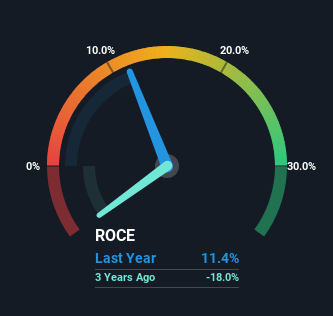Air Canada (TSE:AC) Is Looking To Continue Growing Its Returns On Capital

To find a multi-bagger stock, what are the underlying trends we should look for in a business? Firstly, we'd want to identify a growing return on capital employed (ROCE) and then alongside that, an ever-increasing base of capital employed. Ultimately, this demonstrates that it's a business that is reinvesting profits at increasing rates of return. So on that note, Air Canada (TSE:AC) looks quite promising in regards to its trends of return on capital.
Understanding Return On Capital Employed (ROCE)
For those that aren't sure what ROCE is, it measures the amount of pre-tax profits a company can generate from the capital employed in its business. To calculate this metric for Air Canada, this is the formula:
Return on Capital Employed = Earnings Before Interest and Tax (EBIT) ÷ (Total Assets - Current Liabilities)
0.11 = CA$2.3b ÷ (CA$30b - CA$10b) (Based on the trailing twelve months to December 2023).
Therefore, Air Canada has an ROCE of 11%. On its own, that's a standard return, however it's much better than the 9.1% generated by the Airlines industry.
Check out our latest analysis for Air Canada

In the above chart we have measured Air Canada's prior ROCE against its prior performance, but the future is arguably more important. If you're interested, you can view the analysts predictions in our free analyst report for Air Canada .
What The Trend Of ROCE Can Tell Us
Investors would be pleased with what's happening at Air Canada. Over the last five years, returns on capital employed have risen substantially to 11%. The amount of capital employed has increased too, by 25%. So we're very much inspired by what we're seeing at Air Canada thanks to its ability to profitably reinvest capital.
In Conclusion...
In summary, it's great to see that Air Canada can compound returns by consistently reinvesting capital at increasing rates of return, because these are some of the key ingredients of those highly sought after multi-baggers. And since the stock has fallen 42% over the last five years, there might be an opportunity here. That being the case, research into the company's current valuation metrics and future prospects seems fitting.
On a final note, we found 2 warning signs for Air Canada (1 is a bit unpleasant) you should be aware of.
While Air Canada isn't earning the highest return, check out this free list of companies that are earning high returns on equity with solid balance sheets.
New: Manage All Your Stock Portfolios in One Place
We've created the ultimate portfolio companion for stock investors, and it's free.
• Connect an unlimited number of Portfolios and see your total in one currency
• Be alerted to new Warning Signs or Risks via email or mobile
• Track the Fair Value of your stocks
Have feedback on this article? Concerned about the content? Get in touch with us directly. Alternatively, email editorial-team (at) simplywallst.com.
This article by Simply Wall St is general in nature. We provide commentary based on historical data and analyst forecasts only using an unbiased methodology and our articles are not intended to be financial advice. It does not constitute a recommendation to buy or sell any stock, and does not take account of your objectives, or your financial situation. We aim to bring you long-term focused analysis driven by fundamental data. Note that our analysis may not factor in the latest price-sensitive company announcements or qualitative material. Simply Wall St has no position in any stocks mentioned.
About TSX:AC
Air Canada
Provides domestic, U.S. transborder, and international airline services.
Undervalued with questionable track record.
Similar Companies
Market Insights
Community Narratives




